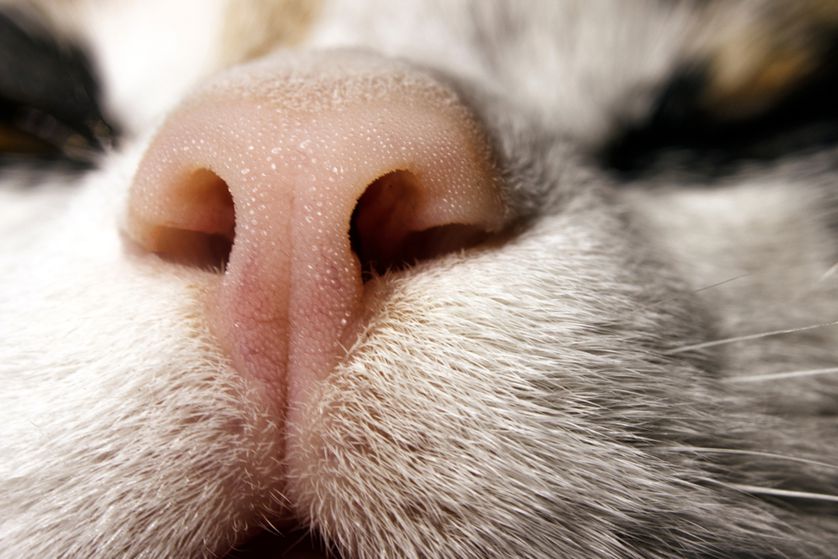One of the most persistent myths about cats is that their warm and dry nose is a sure sign of their health status. In fact, the nose of your furry friend can quickly change its state from warm and dry to wet and cold and back.
If you think twice, such a thing sounds too simple to be a real warning for severe health conditions, right?
It is a whole other matter if the warm and dry nose of your cat appears in combination with other issues such as lethargy, loss of appetite, vomiting, and diarrhea.
Also, you should start worrying if noticing changes in nose color and texture, including the occurrence of cracks, flakes, sores, or crusts. So, one of the crucial things is to know how the healthy nose of your pet looks. That way, you can react timely if you notice any unusual changes in it. Let's take a closer look at the problem.
Why the Nose of Your Cat is Dry

My first advice is to avoid relying on the warmth of the nose of your cat if it is the only symptom.
Why? For example, it may become dry and warm because your furry friend has enjoyed the sun a little bit longer. Also, the warmth and dryness of your pet's nose may vary a few times during a day.
Not to mention that your cat's body temperature is higher than yours, and its nose may feel warm to you even though everything is all right.
In fact, there are many cats with noses that are always warm and dry. The real concern appears when the usually cold and wet nose becomes dry and warm suddenly. It is not difficult to see the difference.
Anyway, the first thing you should do when noticing such a change is to check the following:
- Has your cat laid in the sun for a while during the hot summer day?
- Has it spent too much time in a room with inadequate air circulation during a sweltering sunny day?
- Has it spent time next to a source of heat in winter?
- Has the cat licked the nose and saliva quickly dried on its skin?
In a case that the answers to all these questions are - NO, you should consider visiting a veterinarian. However, before you go to the ambulance, firstly check the body temperature of your lovely pet and its overall behavior.
Dry Nose Combined With Other Symptoms
As I have already said, you have no reason to worry because of a dry nose. However, combined with other symptoms, it can become a problem.
Troublesome changes on the nose:
Crusts and cracks - The nose of your cat may become extremely dry, flaky, crusty, or cracked. That condition may indicate a pemphigus foliaceus. It is a quite severe skin problem that requires veterinary treatment.
Sores and blisters - With the progress of the disease, you will spot the occurrence of sores and blisters on the cat's nose. In that case, formed lesions will start oozing at some point.
Furrows - In some cases, these changes may be a result of bleeding.
Wounds - Even the smallest ones should get your attention. Sometimes, they occur after a fight between cats. It is not uncommon, especially if you have a male cat. If your tom does not leave the house, you should check with your vet if these wounds are due to a pathological condition.
Runny nose - The next step is to look for a runny nose. The mucus should be clear. Bubbly, thick, or colored discharge, especially if it is yellow, green, brown, or black, is a sign that you should go to the veterinarian immediately. Your cat may suffer from skin irritation (dermatitis), viral infection (rhinotracheitis), or even carcinogenic process.
Change of nose color - The nose of your cat is probably pink, liver-colored, black, or the same color as the fur, depending on genetics. Every discoloration is a worrying sign. If you notice these changes, make an appointment with your vet right away.

However, there are a few exceptions! You should not have a reason to worry if the nose of your cat fades during winter. It is a natural condition called a 'winter' or 'snow' nose. It will return to the regular color in spring.
So-called orange tabbies (ginger cats) often have the weird color of the nose full of freckles. Don't worry; they are entirely benign and cannot cause a severe issue.
Some cats are hypersensitive to plastic bowls. As a result, their nose may become lighter. Solve the problem by purchasing an aluminum bowl.
Also, be aware that some breeds such as calico cats may develop black spots on their noses in old age. That harmless pigmentation change is well-known as lentigo simplex.
If your cat suffers from vitiligo (immune-mediated skin disease), its nose will become light pink. However, this condition is quite rare in cats.
If your beloved pet accidentally scratches its nose, you will notice a pink abrasion in that area. However, its nose will turn back to the natural color after the scab falls away.
Check the body temperature
The average feline temperature ranges from 100 to 102.5 F (37.8 - 39.2 C). You can quickly measure it with a thermometer, but I can understand that you probably do not want to insert that instrument into the rectum of your cat. In that case, look for other symptoms of dehydration or diseases.
Signs of dehydration
The combination of a dry nose and high temperature is not a good sign at all. However, the whole thing becomes much more serious when you notice symptoms such as lethargy as well as refusing to take water and food.
Plus, you should check the level of dehydration. The most effective way is to examine the skin across the shoulder of your cat. Stretch it with your fingers and determine how long it takes to return to the normal.
Keep in mind that the skin of a well-hydrated and healthy cat will return to its place right away. If your furry friend is dehydrated, its skin will remain in a fold for a while.
Other Signs
Trouble breathing, unusual respiratory sounds, nosebleeds, or sneezing may indicate the occurrence of an infection, the presence of a foreign body, tooth root abscess, or even a nasal tumor.
Diseases of the Cat's Nose
Unfortunately, dry and warm nose of your beloved cat may indicate a few severe medical conditions, including:
Allergies
Like humans, your cat can also suffer from various allergies, such as food allergy, contact allergy, or inhalant allergy. The result is dermatitis, followed by dry and scaly skin.
There are a few problems with this issue. Firstly, allergies in cats are challenging to diagnose. Secondly, they are often the first step leading to more severe yeast and bacterial infections. Your veterinarian will set a proper diagnosis by testing. There are two relevant tests:
- Allergy testing
- Hypoallergenic food trial
Pemphigus complex
These autoimmune skin infections affect cats more often than you can imagine. The two main types of the disease are:
Pemphigus foliaceus - The first signs are patches of reddish skin on the nose, but they may affect other parts of the cat's body over time. That means that you can notice changes in the ears, paws, and the whole body eventually.
Pemphigus erythematosus - Red patches will appear on the nose, face, head, and paws. Over time, they will turn into blisters and crusts, causing discoloration of the skin and falling hair loss.
Pemphigus vulgaris - It is a rare disease followed by blisters and ulcers on the nose, lips, and eyelids.
Solar Dermatitis
Prolonged exposure to natural sunlight may cause problems for your cat. UV light damages skin cells, especially if the cat has un-pigmented skin. Additionally, this condition leads to infection followed by lesions on the nose and ears.
The diagnostic is a bit tricky because the vet needs to exclude all other causes of flaky lesions on the cat's skin first. Try to keep your cat safe far away from direct sun. Once the problem occurs, solve it with antibiotics and anti-inflammatories to avoid possible skin cancer.
Fungal Infection
Fungi, including the most common ringworms, can cause changes to a cat’s nose, including both inside and outside parts. The usual ways of spreading the fungal skin infection are:
- Fungal spores from the air
- Direct contact with infected animals
In such cases, the veterinarian will diagnose the infection by taking a sample skin or hair and their incubation on culture medium. Once this contagious infection is diagnosed, you need to treat your cat with anti-fungal medications.
Parasites
Unfortunately, mites do not cause problems to the dog's owners only. Cats may have difficulties with Demodex and scabies, as well.
After taking a skin scrape or a skin biopsy, your vet will do the tape cytology test and prescribe an adequate treatment.
Conclusion
Let me make myself clear. Contrary to popular opinion, there is no reason for panic if the only symptom you can notice is a dry and warm nose of your cat. Take these changes seriously only if you notice additional symptoms, including changes in behavior, lethargy, high temperature, or unusually poor appetite. In that case, do not try to cure your cat yourself, but take it to a vet immediately,

Jovanka Panic
My name is Jovanka Panic. I am a writer, translator, veterinarian, humanitarian, and a passionate traveler. After playing with white bears and elephants in the Belgrade ZOO and dealing with Rabies virus in the Institute Pasteur, I enjoy writing. My five beasts are my ultimate love, including three cats (Clementine, Josephine, and Sophia) and their 'mom' American Stafford Terrier (Malena).
Does your cat need a new bed?
Browse our endless array of hand made cat caves.

